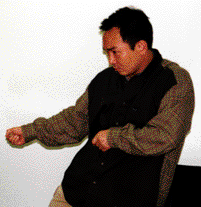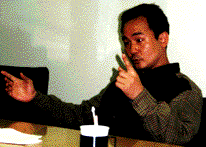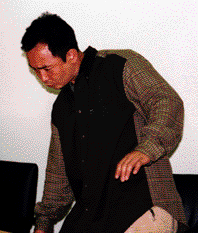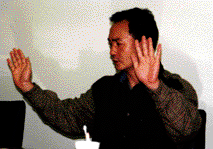



...Dancing all Night, This is No Dance Theory [part 6]
ITOH: In this discussion I would like to think about the meaning of "acting and gesture." I have called upon the famous mime NAKAMURA Yuji to be our special instructor to whom we can consult about acting in pantomime.
NAKAMURA: Basically, Pantomime is the art of the "mute." The reason why there is no speaking in pantomime therefore, is originally connected to the "inability to speak."
ITOH: Such as Harpo MARX.
NAKAMURA: Yes, so when I asked Steven BERKOFF about the "transformation" of pantomime, he said that as an indigenous art "it was not able to enter the larger theaters." And because he and other mimes were confined to smaller theaters, their movements were also confined. It is an art, then, that takes place on the grounds outside of the larger theaters.
SAKURAI: Therefore it's called a "popular art."
NAKAMURA: Yes, and this is why we're against the notion that the mime emerges from the high culture of traditional European art, because in fact the figure is more related to low art.
ITOH: I see.
 NAKAMURA: This is something that I, too, have just come to understand. In the West the focus on movement seems to be eliminated. When there is a scene in a play that requires movement, for example, the director might have no connection to that at all.
NAKAMURA: This is something that I, too, have just come to understand. In the West the focus on movement seems to be eliminated. When there is a scene in a play that requires movement, for example, the director might have no connection to that at all.
OSHIKIRI: Like the role of the "tateshi" (a teacher of a sword battle) would play in film.
NAKAMURA: Right. That emerges from the person who is a specialist in movement and never says a word. Instead, this person will only be concerned with the best way to move.
ITOH: This might have something to do with the type of dialogue, since Western theater has its linguistic origins in Greek drama.
SAKURAI: But didn't MARCEAU perform in a big theater in France?
NAKAMURA: No, I don't think he did.
ITOH: It is like MARUSE Taro (laughter). The art is brilliant, but it could never be seen in a large theater.
NAKAMURA: People have various images of what a mime is and the scope of these images is quite broad. There are those who watch me dance and say, "is that a mime?" Or when we do a gag or a short skit to make people laugh, there are those who say "ah, that's a mime." There are so many various responses.
SAKURAI: Speaking about Japanese mimes, weren't there several mimes in the past, such as YONEYAMA Mamako, who were very artistic? Do you think that those types of mimes were aiming against a sense of reality?
NAKAMURA: Yes, and in the modern theater this aim persists.
SAKURAI: I'm not really sure what it would look like, but I think that very artistic mimes would not be aiming towards realism but towards something more poetic, perhaps they are performing a "poem".
NAKAMURA: I would have to say that that is the way to become a poor mime.
ITOH: For example, when a balloon inflates a mime might delicately act this out with his or her hands. Isn't this a special type of pantomime realism? Where does this movement come from?
NAKAMURA: Traditionally, there's a theory about this. It's called "unification," which means that I would express the form of the balloon being inflated, yet the balloon itself is not able to be seen. In order to express something, then, I am forced to express it only with my body. That's "unification..
ITOH: You become the balloon, while at the same time the object of the balloon appears to be in your hands.
NAKAMURA: For example, when you begin to blow up a balloon, your body, as well as the balloon, begins to swell.
ITOH: Yes, isn't that the distinctive pantomime movement. It's all of that.
 NAKAMURA: By making my chest very soft when I pull a rope, for instance, the rope is able to be seen. When my chest is stiff, that's a stick. This is the principle of "unification". If my chest is not soft then you are not able to see the rope. This was all created by MARCEAU's teacher. So my friends in France always criticize MARCEAU because it was his teacher who was so great, while MARCEAU only made all of the money.
NAKAMURA: By making my chest very soft when I pull a rope, for instance, the rope is able to be seen. When my chest is stiff, that's a stick. This is the principle of "unification". If my chest is not soft then you are not able to see the rope. This was all created by MARCEAU's teacher. So my friends in France always criticize MARCEAU because it was his teacher who was so great, while MARCEAU only made all of the money.
ITOH: In Ballet there are no objects to be expressed. While in Kyogen there are objects. When Kyogen actors close a door they might make the sound of a door with their voice.
NAKAMURA: Yes, they do that.
ITOH: Now, if we compare pantomime with Noh and Kyogen, the various ways of acting in Kyogen have been reduced in Noh. And with modified dances, there is the feeling that the evidential principle has been eliminated. But when recently watching a Noh performance of "Nonomiya," the very end contained an important part in which the actor concealed his face with a fan. He did this three times in all, and he was thereby able to symbolically "explain" the subtle feeling. I wonder if we can't say that with the acting reduced, in the end the remaining gestures are transmitted even more intensely?
SAKURAI: Because there is more movement in Kyogen compared to Noh and because it tends more to the body, isn't Kyogen essentially a theatrical art based on dialogue? Although it is vital to retain strict control over one's acting, the theatrical structure of Kyogen does not compel one to be symbolic. For me, I have never found Kyogen that interesting. When I was watching the skit "Oyakusoku," I couldn't help but think that the characters and patterns were like the MARX brothers or Mr. Kitarou. Why was that?
ITOH: Because since the modern, there has been little effort to preserve the genre.
SAKURAI: This is connected to what Yuji indicated earlier regarding pantomime and not being able to speak. In the case of Noh, when the shite [main character] is on stage he does not speak, this is, rather, left to the Noh chanters. In Kyogen, the actor is talkative, but his body doesn't talk (in other words there are limits on his bodily movement). Would you agree that there has been a deformation of the body therefore eroding its eloquence?
 OSHIKIRI: In Noh, what is exhilarating is the way an actor tries as hard as possible to reduce the acting down to the smallest possible degree. In this way the self equals the cancellation of the body. But this is an ideal, and in contemporary Noh I'm not sure whether everyone can notice this. Still, it is probably not a bad thing that the appreciation of Noh is not overly intellectualized. In Noh, even if a person does not understand anything about it, he or she still can feel it (such as the case with many foreigners), and it is this that distinguishes it from Kyogen and why I am not as fond of Kyogen.
OSHIKIRI: In Noh, what is exhilarating is the way an actor tries as hard as possible to reduce the acting down to the smallest possible degree. In this way the self equals the cancellation of the body. But this is an ideal, and in contemporary Noh I'm not sure whether everyone can notice this. Still, it is probably not a bad thing that the appreciation of Noh is not overly intellectualized. In Noh, even if a person does not understand anything about it, he or she still can feel it (such as the case with many foreigners), and it is this that distinguishes it from Kyogen and why I am not as fond of Kyogen.
ITOH: Speaking about that, have you worked in Kyogen, Yuji?
NAKAMURA: I studied at training school with the teacher NOMURA Mannojyo.
ITOH: At that time did you learn various things about acting?
NAKAMURA: Basically before learning about acting one must master how to dance and chant and I never went beyond that point. It was really something. There are so many proper dances and chants that one must perform.
ITOH: In Mime and Kyogen, the lower half of the body is stiff. Isn't this essentially like a puppet?
NAKAMURA: The type of training that is needed to learn the puppet's movement is not related to a mime's training. One day, however, my teacher suddenly said, "go do a part time job with puppets," and "learn from your seniors."
SAKURAI: Were you able to understand how it applied? Is it something you could watch and then understand.
NAKAMURA: I think so. I was able to discover my own principles, such as the curves of my body and how not to close my eyes. But since each person is different this type of work is usually left to the individual.
OSHIKIRI: For a mime it's a type of "look and learn" world.
ITOH: When you are acting like a puppet, does it feel just like a puppet? What's the trick?
 NAKAMURA: You must not react. When performing like a puppet, you would react if your line of vision met the spectator's. That is why the gaze should be vaguely focused.
NAKAMURA: You must not react. When performing like a puppet, you would react if your line of vision met the spectator's. That is why the gaze should be vaguely focused.
ITOH: So it is essential to meet the eyes. That is also an important acting technique for portraying strangeness.
NAKAMURA: And no matter what happens you absolutely cannot move your eyes. You must only look roughly at things. If the other person moves closer to you, then you must respond. There can be nothing less than that level of communication. That's my technique.
OSHIKIRI: What stage is that in the Bella System?
ITOH: The Bella System? What's that?
NAKAMURA: It is a systematic acting technique in which a large circle is formed and the acting is broken up so that the first person forms circle number one, the next two people form circle number two, the next three circle number three and so on. In the first circle it is just one person dealing with their internal feelings. The second circle has a partner and the third consists of an open space between the members. This is how one is forced to train. For example, if the first person's line is "I was bad," he or she must speak to oneself and say something like "I was bad!" Since there is a partner in the second group, one actor might say to the other "I was bad, you know." In the third group, one might want to insert oneself into a past narrative and say "I was bad" in order to generate a recollection of an imaginary past event by the circle. It is this type of compilation that makes up the Bella System.
SAKURAI: Is it a dramatic system?
NAKAMURA: Yes it is, but Bella, the woman who created the system, intended it to be an objectless drama. In this way it is quite similar to a mime.
ITOH: You mean a speaking mime?
NAKAMURA: But it is not as if a mime's expression is totally different. Although they do not vocalize anything, they still must feel. The quality of the feelings should still be deep. Tamasaburo uses this system as well.
OSHIKIRI: Tamasaburo does this when he dances. First he'll perform a dance, and then he'll dance again and the spectators will be able to distinguish between the two.
ITOH: What is the degree of consciousness regarding one's behavior? When performing what was earlier called "unification," it seems to require delicate muscular movement in order to produce something very natural. Does a mime discipline his or her muscles? In other words, although copying everyday movement, is there a different way of expressing the muscles?
NAKAMURA: Yes, yes. So when you are pulling something, you are actually pushing it.
OSHIKIRI: When you are lifting a heavy bowling ball, for example, in fact you are pushing it. It produces an optical illusion.
 NAKAMURA: Even though a bowling ball is an odd shape, since everyone has lifted one, the spectators cannot see the weight of it. By pushing, then, the weight is able to be expressed.
NAKAMURA: Even though a bowling ball is an odd shape, since everyone has lifted one, the spectators cannot see the weight of it. By pushing, then, the weight is able to be expressed.
SAKURAI: You perform the opposite.
 NAKAMURA: The same is true for a wall. When practicing I always begin by looking in a mirror. And I'm never quite sure where to put my hands. The more I practice the more I am able to feel where the space is until things are finally worked out. Only by looking am I able to work through this.
NAKAMURA: The same is true for a wall. When practicing I always begin by looking in a mirror. And I'm never quite sure where to put my hands. The more I practice the more I am able to feel where the space is until things are finally worked out. Only by looking am I able to work through this.
SAKURAI: This is a bit off the subject, but does pantomime have its lineage connected to France?
NAKAMURA: Well, it's not limited to France. For example, the Pierrot is only one character of pantomime. There is also the Harlequin, Mars, Earth and others. The Pierrot has a certain type of movement, and the Mars, from Venice, has a more aggressive movement.
SAKURAI: Yes, with its origins in the Italian Commedia Dell'Arte.
ITOH: This is a type of mask drama. So one's movement must be just as the character is. This is a type of popular culture that is common knowledge, so with a well-known narrative a background does not need to be established.
NAKAMURA: Recently, I watched a Japanese drama on NHK, but I could not figure out what was so interesting about it. If only looking at the dancer without paying attention to the shamisen or chanters, it was not as if I was saying "what is this person doing." Of course since there were chanters the content was understandable from the beginning, but I could still understand even without listening to the chanters. The meaning is that by the training of the body alone, the meaning could be expressed.
SAKURAI: If you think about it, the real conditions are relayed step by step, "here is a door. I turn the knob, the door is open"
NAKAMURA: That's why the mime is more interesting.
ITOH: Isn't this the dilemma of modern dance?
NAKAMURA: I don't appreciate dance in which its movements seems to be like speaking. The effectiveness of dance is in ad-libbing. Without being able to laugh, modern dance is handicapped.
ITOH: It must shed itself of that limitation. Dance should be like speaking one's own language--a language that satisfies oneself.
 NAKAMURA: The most fascinating part of mime, the movement, training, the beauty of the body, is quickly disappearing. Whether one is fat, short, or unable to move ones hands, a mime can still generate laughter. And for a mime, after making one trip around a square, the place changes and the time changes, so the mime must account for this.
NAKAMURA: The most fascinating part of mime, the movement, training, the beauty of the body, is quickly disappearing. Whether one is fat, short, or unable to move ones hands, a mime can still generate laughter. And for a mime, after making one trip around a square, the place changes and the time changes, so the mime must account for this.
SAKURAI: This freedom to make decisions seems similar to Noh and Kyogen.
ITOH: Noh, Kyogen and pantomime seem to be the same for both sexes. Are the forces similar?
OSHIKIRI: You mean when clinging to a stick or pulling a thread?
SAKURAI: Yes, it's all assumptions. Since it is not a concrete thing, a single line has a space of assumptions and if that line becomes twisted then the line is distorted. Pantomime is close to this. It has to do with abstraction.
ITOH: I wonder if this abstraction hides something?
NAKAMURA: Such as Martial Arts in which I try to see the hidden battle underneath the movements. Don't you think that the skills today are simply one-dimensional? I really want to see what is not revealed, the combat while it is being hidden.
ITOH: The Judo in the Olympics has become quite uninteresting.
OSHIKIRI: It was full of tie-ups that the referees had to manage.
NAKAMURA: What is it with this "superior victory?" Doesn't it seem foolish that the attackers would almost always win their matches?
ITOH: When two Sumo wrestlers are in a tie-up there is a very interesting type of muscular communication going on, but in Judo this is not the case so it really needs to be abolished.
OSHIKIRI: It's all right not to predominate.
ITOH: "In sports and dance, that which is subtly "hidden" is most important. And it is this "hidden" thing that becomes the truth of abstract power."
(ITOH Seikoh,Writer/ OSHIKIRI Shinichi, Writer/SAKURAI Keisuke, Musician/ NAKAMURA Yuji, Mimer)
Translation: Eric CAZDYN
ITOH Seikoh Home Page
http://www.sdw.com
SAKURAI Keisuke Home Page
http://www.t3.rim.or.jp/~sakurah/index.html
 NAKAMURA: This is something that I, too, have just come to understand. In the West the focus on movement seems to be eliminated. When there is a scene in a play that requires movement, for example, the director might have no connection to that at all.
NAKAMURA: This is something that I, too, have just come to understand. In the West the focus on movement seems to be eliminated. When there is a scene in a play that requires movement, for example, the director might have no connection to that at all.



 NAKAMURA: By making my chest very soft when I pull a rope, for instance, the rope is able to be seen. When my chest is stiff, that's a stick. This is the principle of "unification". If my chest is not soft then you are not able to see the rope. This was all created by MARCEAU's teacher. So my friends in France always criticize MARCEAU because it was his teacher who was so great, while MARCEAU only made all of the money.
NAKAMURA: By making my chest very soft when I pull a rope, for instance, the rope is able to be seen. When my chest is stiff, that's a stick. This is the principle of "unification". If my chest is not soft then you are not able to see the rope. This was all created by MARCEAU's teacher. So my friends in France always criticize MARCEAU because it was his teacher who was so great, while MARCEAU only made all of the money. NAKAMURA: You must not react. When performing like a puppet, you would react if your line of vision met the spectator's. That is why the gaze should be vaguely focused.
NAKAMURA: You must not react. When performing like a puppet, you would react if your line of vision met the spectator's. That is why the gaze should be vaguely focused.  NAKAMURA: Even though a bowling ball is an odd shape, since everyone has lifted one, the spectators cannot see the weight of it. By pushing, then, the weight is able to be expressed.
NAKAMURA: Even though a bowling ball is an odd shape, since everyone has lifted one, the spectators cannot see the weight of it. By pushing, then, the weight is able to be expressed.  NAKAMURA: The same is true for a wall. When practicing I always begin by looking in a mirror. And I'm never quite sure where to put my hands. The more I practice the more I am able to feel where the space is until things are finally worked out. Only by looking am I able to work through this.
NAKAMURA: The same is true for a wall. When practicing I always begin by looking in a mirror. And I'm never quite sure where to put my hands. The more I practice the more I am able to feel where the space is until things are finally worked out. Only by looking am I able to work through this.
